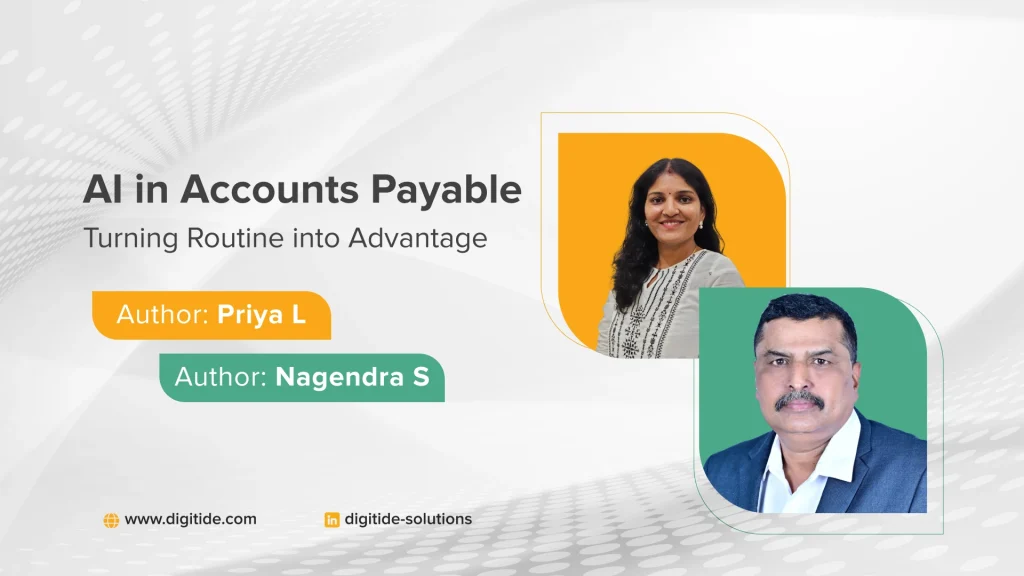Ask any finance leader which part of their department feels the most repetitive and time-consuming, and the answer
is often the same: Accounts Payable. Endless invoice entry, approval follow-ups, and reconciliation can make it feel
like a never-ending task. It is necessary work, but it rarely gets recognition.
This is why Artificial Intelligence is changing everything. Accounts Payable (AP) is moving from a reactive, manual
process to a proactive and strategic function that adds real value. AI is not just improving speed; it is transforming how
finance teams operate and think.
From Manual Entry to Intelligent Automation
Traditional Accounts Payable relies heavily on manual eeort. Someone has to key in invoice details, verify vendor
information, and con\rm every amount. Even systems with basic automation often require human review.
AI takes this further. Instead of just scanning invoices, AI understands them. It reads supplier names, extracts amounts,
identifies currencies, and even processes handwritten notes. Through natural language processing, AI can interpret
complex and unstructured documents. Machine learning models improve accuracy over time as they process more
data.
Tasks that once took hours now take minutes. Finance teams are no longer buried in data entry. They can focus on
analysis and control rather than correction.
Smarter Matching and Fewer Exceptions
One of the biggest delays in AP is the three-way match between the purchase order, goods receipt, and invoice. AI
simplifies this process by comparing all three automatically. It verifies quantities, prices, and supplier details in real time.
When mismatches occur, AI does not simply flag them. It explains the diffrence and suggests possible resolutions. It
may highlight a one-unit quantity variation or a currency conversion issue. This helps teams focus only on genuine
exceptions, which improves accuracy and saves time.
Fraud Detection and Compliance Reinvented
Fraud in Accounts Payable often hides in duplicate invoices, infated pricing, or fake vendors. AI systems are built to
notice unusual activity that might otherwise go undetected. They monitor vendor behavior, flag suspicious payment
requests, and identify duplicate records even if invoice numbers differ slightly.
Compliance also becomes easier. AI validates each transaction against company policies, tax rules, and payment terms.
It ensures that every invoice is processed in line with internal controls. This reduces audit risk and strengthens overall
financial governance.
Predictive Insights for Better Decisions
Once the manual work is removed, Accounts Payable becomes a source of insight. AI can analyze spending trends,
forecast upcoming liabilities, and identify opportunities for early payment discounts.
Finance leaders gain a clearer understanding of cash flow and supplier performance. They can predict delays, plan
payments more strategically, and manage working capital with greater confidence. The AP function becomes an active contributor to business planning rather than a back-office task.
A Better Experience for Everyone
AI improves life for suppliers and employees alike. Vendors receive payments faster and with fewer disputes.
Procurement teams gain real-time visibility into spend data and compliance. CFOs can access dashboards that show
the complete picture of cash flow, pending approvals, and process efficiency.
Employees benefit the most. They move from repetitive data entry to meaningful analysis and supplier engagement.
This shift not only improves efficiency but also builds morale and ownership.
Getting Started with AI in AP
Transformation does not need to begin with a complete overhaul. Most organizations start with a pilot project in one
area, such as invoice capture or validation. The goal is to build confidence and gather data.
Success depends on clean data, consistent processes, and proper integration with existing ERP or procurement
systems. As AI learns from historical transactions, accuracy improves quickly. Over time, the organization can expand
automation across matching, approvals, and payments.
Change management is essential. AI does not replace people; it supports them. Training the team to review AI outputs,
understand exception handling, and interpret analytics ensures long-term adoption.
The Future of Accounts Payable
The future of AP is autonomous. Invoices will be received, verified, and paid with minimal human touch. Finance teams
will step in only when something truly unusual occurs. Many organizations already achieve over 80 percent straight through processing rates. AI will make AP faster, smarter, and more strategic. It will not only reduce cost but also
enhance compliance, transparency, and decision-making.
Conclusion
AI in Accounts Payable is not about removing people from the process. It is about allowing people to focus on
higher-value work. By automating the repetitive and error-prone steps, AI unlocks insights and efficiency that were
previously hidden.
The end goal is simple: an Accounts Payable function that runs intelligently, supports business growth, and helps
finance teams deliver real impact every day.
That is the power of AI in Accounts Payable.
